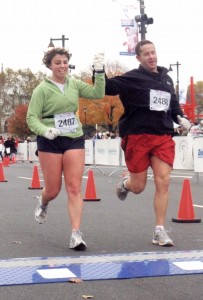Are you thinking about completing a fall race? Whether it’s a 5K, 10K, or half or full marathon, it’s going to be here before you know it. I’ve been running for years, and I can tell you, there’s nothing like the motivation of signing up for a race to get those bottom cheeks in gear and get you back into a fitness routine. Right now, I’m training for an Ironman. Yes, I admit that it’s absolutely nuts. Full time job, 2 energetic little boys, and a hyper puppy - who has time for that?! 5.5 more weeks to go. Yes, in 5.5 weeks I will cross that magical life-changing line and be an IRONMAN. A finisher. Five. And a half. More. Weeks. But until I get there, there’s training. Exercise and training, especially when you’re pushing yourself to try something new, is hard. But if it were easy, it wouldn’t be a challenge, right?! Here are six tips to help you successfully reach the finish line:
 1. Sign up for the race. Make the commitment. I can’t tell you how many of my clients will tell me they’re thinking about doing __(fill in race name here)__ but want to wait until the feel ready to race before they actually put down the cash and register. It’s one of those things that if you wait until you know you can, you might never do it. It’s kind of like having a baby. NO ONE is ever truly ready to be a parent until you are one. Then you figure it out. Assuming you have ample time to train, there’s no need to be able to complete the distance on registration day, so, go ahead and register.
1. Sign up for the race. Make the commitment. I can’t tell you how many of my clients will tell me they’re thinking about doing __(fill in race name here)__ but want to wait until the feel ready to race before they actually put down the cash and register. It’s one of those things that if you wait until you know you can, you might never do it. It’s kind of like having a baby. NO ONE is ever truly ready to be a parent until you are one. Then you figure it out. Assuming you have ample time to train, there’s no need to be able to complete the distance on registration day, so, go ahead and register.
 2. Tell people about it. That’s right. Start talking about it. To everyone. By talking about it, you’ll get excited and motivated to train and people will also ask you about it. “How’s the training going?” You don’t want to let down your fans, do you? Be able to give them something you’re proud of like how many miles you ran that week or what you’re planning to do on your next long workout.
2. Tell people about it. That’s right. Start talking about it. To everyone. By talking about it, you’ll get excited and motivated to train and people will also ask you about it. “How’s the training going?” You don’t want to let down your fans, do you? Be able to give them something you’re proud of like how many miles you ran that week or what you’re planning to do on your next long workout.
3. Have a training plan and follow it with flexibility. The visual guide of a training plan gives you yet another dose of motivation. I like to post mine so I know where I’m going and what I need to do to get there. Don’t get too stuck on the exact days of the week or times of day. We all have other things going in our life besides training for a race, so do as much as you can, but be ok with shifting or even skipping a run here and there to take your daughter to the get her teeth cleaned or when you’re just not feeling well. The long workouts (which are typically only 1x per week) are the ones where you’re teaching your body how to efficiently use energy to make it through the race. These are the workouts I strongly recommend making a priority. Slacking on these will greatly compromise your performance on race day. (Trust me on this one. Actually training makes your race go much better!) Looking for a training plan? Find 2 at the end of this post.  NOTE: If you end up with pain during your training, your #1 priority becomes healing and rest. Do not “push through” pain as this will most likely make the injury worse and could compromise you even starting the race. This leads us to…
NOTE: If you end up with pain during your training, your #1 priority becomes healing and rest. Do not “push through” pain as this will most likely make the injury worse and could compromise you even starting the race. This leads us to…
 4. Rest when you need rest; make an effort to recover. Rest includes making sleep a priority as well as ensuring that rest and recovery efforts are included in your training plan. Your body “cleans up and puts itself back together” at night while you sleep so you’re ready to go for the next day. Think of what your kitchen looks like after cooking dinner. The cooking and eating dinner are your training, the post dinner cleanup is your rest. If you don’t clean up after dinner, you’re left with a mess in the morning. You can still cook with the mess, but at some point, no cleaning results in the inability to cook, much less eat since you can’t even find the kitchen and there are no clean dishes. Rest days allow your muscles and joints extra time to repair themselves. If a muscle or joint gets tweaked at any point during your training, taking an extra day or two (or even week or two for more serious injuries) is well worth it. Yes, you might lose a little endurance by taking some time off, especially a week or more, but taking some time off increases your chances of finishing the race (as opposed to being injured.) While training for my first marathon, I strained my Achilles tendon. A time off of running, lots of ice wraps, and some extra sleep and I was back on track a week later and successfully finished Philly. Regularly adding recovery efforts into your training plan helps prevent injury and keep your body feeling limber. For some, these efforts make training possible. I have tennis ball that lives under my desk and I like to get in the water at least 1x per week. Regularly practicing yoga keeps my joints and brain happy. Here's a short list of scientifically proven effective recovery efforts:
4. Rest when you need rest; make an effort to recover. Rest includes making sleep a priority as well as ensuring that rest and recovery efforts are included in your training plan. Your body “cleans up and puts itself back together” at night while you sleep so you’re ready to go for the next day. Think of what your kitchen looks like after cooking dinner. The cooking and eating dinner are your training, the post dinner cleanup is your rest. If you don’t clean up after dinner, you’re left with a mess in the morning. You can still cook with the mess, but at some point, no cleaning results in the inability to cook, much less eat since you can’t even find the kitchen and there are no clean dishes. Rest days allow your muscles and joints extra time to repair themselves. If a muscle or joint gets tweaked at any point during your training, taking an extra day or two (or even week or two for more serious injuries) is well worth it. Yes, you might lose a little endurance by taking some time off, especially a week or more, but taking some time off increases your chances of finishing the race (as opposed to being injured.) While training for my first marathon, I strained my Achilles tendon. A time off of running, lots of ice wraps, and some extra sleep and I was back on track a week later and successfully finished Philly. Regularly adding recovery efforts into your training plan helps prevent injury and keep your body feeling limber. For some, these efforts make training possible. I have tennis ball that lives under my desk and I like to get in the water at least 1x per week. Regularly practicing yoga keeps my joints and brain happy. Here's a short list of scientifically proven effective recovery efforts:
- Myofacial release: foam rolling, tennis ball rolling, and sports massage
- Hydro-therapy: ice baths, swimming, water walking, gentle water aerobics, and salt baths
- Range of motion activities: stretching, yoga, restorative yoga, and even some strength training workouts.
 5. Nutrition is important. Racing or not, nutrition is important. Fueling your body is a life necessity. Fuel your body with nutrient rich foods - a combination of healthy fats, carbohydrates, and proteins, lots of beautiful colors, and minimal processing. A healthy diet helps prevent illness and injury and overall, helps maintain a healthy body weight, and just makes you feel good. When you’re asking your body to do harder work, your nutrition requirements will also change and where you might have been ok with an ok diet before starting your training plan, when you’re “in training,” fine tuning your nutrition habits helps increase your recovery time and success. If you’re training for over an hour, you will need to fuel your body during the event itself. Practicing race day fueling during your training is key. Gastric distress and/or “hitting the wall” during a race is really no fun. I love touring, but touring the porta potties every mile for the last 5 miles of your marathon – no thank you. Or, maybe even worse, “hitting the wall”: the state of getting behind in your nutrition during an endurance event resulting in lead legs and turtle speeds sometimes accompanied with intense pain, cramping, injury, and/or the inability to finish the race. So, nutrition is important. Eat good, healthy food. For more on nutrition, check out Kelly LeSage's post: Fuel Your Training.
5. Nutrition is important. Racing or not, nutrition is important. Fueling your body is a life necessity. Fuel your body with nutrient rich foods - a combination of healthy fats, carbohydrates, and proteins, lots of beautiful colors, and minimal processing. A healthy diet helps prevent illness and injury and overall, helps maintain a healthy body weight, and just makes you feel good. When you’re asking your body to do harder work, your nutrition requirements will also change and where you might have been ok with an ok diet before starting your training plan, when you’re “in training,” fine tuning your nutrition habits helps increase your recovery time and success. If you’re training for over an hour, you will need to fuel your body during the event itself. Practicing race day fueling during your training is key. Gastric distress and/or “hitting the wall” during a race is really no fun. I love touring, but touring the porta potties every mile for the last 5 miles of your marathon – no thank you. Or, maybe even worse, “hitting the wall”: the state of getting behind in your nutrition during an endurance event resulting in lead legs and turtle speeds sometimes accompanied with intense pain, cramping, injury, and/or the inability to finish the race. So, nutrition is important. Eat good, healthy food. For more on nutrition, check out Kelly LeSage's post: Fuel Your Training.
6. Last, but not least: Train your brain. Using positive re-enforcement and visualization can greatly increase overall performance and well as perceived performance. The short story of how I came about training for an Ironman this year, is that my sweet, endearing husband registered me (without my knowledge) for Ironman Chattanooga and last Christmas morning, I opened a package that contained a sweet, encouraging letter that I was in. IN?! AN IRONMAN?! Truly, I’m not the one who’s nuts here. It took me a while to own it and one day, as cheesy as it sounds, I decided that it was time I was IN! As in, ALL IN to train and do this thing. So, I added reminder to my phone that set off every day at 10:00 a.m. that said “Ironman! Yes you can!” ![]()
After days of reading this and some positive self-talk, I was able to hop on board and start training. Another valuable technique of brain training is visualization. Completing any challenge is hard, but visualizing your success is shown to aid in the tough times. There will be at least one moment during the race that you’re going to question your sanity and that’s where mind training is specifically helpful. How do you do it? The most basic form of visualization is to go through race day in your mind from start to finish. Imagine yourself at the starting line, excited about starting but also buzzed by the energy of your fellow racers, hear the horn go off, see yourself running through the course feeling good, and finally imagine that beautiful finish line, crossing it, and the joy you’ll feel in doing so. Close your eyes, and do it now. … … … … How do you feel?
Ready to lace up those shoes and head for a run? I am! ..and ride…and swim, because I have 5.5 weeks left, but if you’re just getting started, go sign up, tell people about it, get yourself a training plan, and get to it!
Looking for a training plan? Look no further! The plans below are intended for the average healthy person who’s new to (or getting back into) running. If you have specific health issues, working with a trainer or a coach is a great way to get a personalized plan that fits you, your body, and your lifestyle. Please consult with your health care provider before starting a new exercise routine.
See you at the finish line!



2 Comments
Pingback: Fuel Your Training - SAS Life
Pingback: Running: Body Awareness and How it’s Done